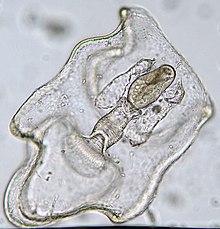Abipinnaria is the first stage in the larval development of most starfish, and is usually followed by a brachiolaria stage. Movement and feeding is accomplished by the bands of cilia. Starfish that brood their young generally lack a bipinnaria stage, with the eggs developing directly into miniature adults

The bipinnaria is free-living, swimming as part of the zooplankton. When it initially forms, the entire body is covered by cilia, but as it grows, these become confined to a narrow band forming a number of loops over the body surface. A pair of short, stubby arms soon develop on the body, with the ciliated bands extending into them.
In addition to propelling the larva through the water, the cilia also catch suspended food particles, and deliver them to the mouth (more correctly called a stomodeum).
Eventually, three additional arms develop at the front end of the larva; at this point it becomes a brachiolaria. In some species, including the common starfish Asterias, the bipinnaria develops directly into an adult.
It is very similar in appearance to the tornaria larvae of some Hemichordata, reflecting the descent of the Ambulacraria from a common ancestor.
Barnes, Robert D. (1982). Invertebrate Zoology. Philadelphia, PA: Holt-Saunders International. pp. 945–946. ISBN 0-03-056747-5.
This echinoderm-related article is a stub. You can help Wikipedia by expanding it. |
This developmental biology article is a stub. You can help Wikipedia by expanding it. |